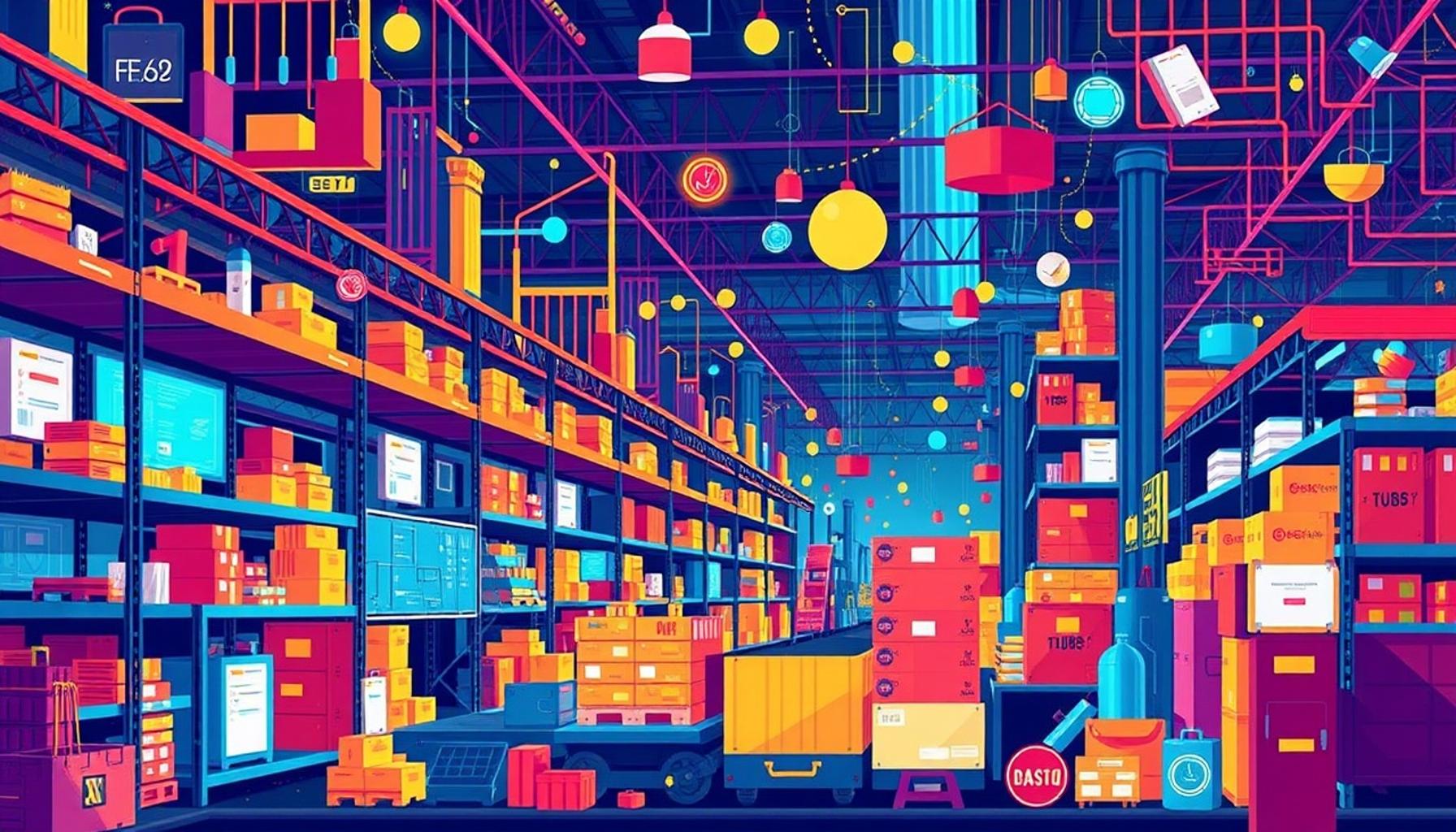The Evolution of Digital Logistics and its Impact on Technology Adoption by Shein

The Evolution of Logistics in the Digital Age
The landscape of logistics has undergone a revolutionary transformation in recent years, particularly fueled by the meteoric rise of e-commerce giants like Shein. This shift is not merely a trend; it marks a fundamental change where advanced technologies are reshaping the supply chain. The integration of these technologies has significantly optimized operational efficiency while simultaneously enhancing customer satisfaction.
Key Changes in Digital Logistics
- Automation: The rise of automation in logistics is at the forefront of efficiency. The use of robotics and artificial intelligence (AI) has streamlined warehouse operations, allowing businesses to sort, package, and ship products more swiftly than ever before. For instance, Amazon employs Kiva robots to transport goods, enabling them to pick and pack items with remarkable speed, which reduces the time from order to delivery.
- Real-time Tracking: Customers now enjoy the ability to monitor their orders from dispatch to delivery with remarkable precision. This capability not only enhances transparency but also builds trust between companies and consumers. The implementation of GPS and RFID technology allows customers to receive updates in real time, enabling them to plan their schedules around delivery times. Companies like UPS and FedEx have successfully adopted such systems, providing an exceptional level of customer service.
- Data Analytics: The utilization of big data analytics has transformed how logistics companies predict and respond to market demands. By analyzing purchasing trends and consumer behaviors, businesses can accurately forecast demand, ensuring they remain agile and responsive to changes. For example, retail giants utilize predictive analytics to stock seasonal products efficiently, ultimately minimizing waste and maximizing sales.
Shein’s rapid growth serves as a prominent case study on how digital logistics can spur technological advancement. The company employs several innovative strategies that not only streamline operations but also enhance user experiences:
- Quick Turnaround: Shein exemplifies fast fashion cycles, using real-time data analytics to make swift decisions regarding inventory and production. This allows them to release new styles in a matter of weeks instead of months, catering to the ever-changing tastes of consumers.
- Global Reach: With a logistics network optimized for international deliveries, Shein has expanded its market far beyond its initial borders. Their efficient logistical strategies empower them to serve customers from various countries, capitalizing on global trends while minimizing shipping times and costs.
- Customer-Centric Approaches: By focusing on tailored experiences based on consumer behavior, Shein fosters loyalty and satisfaction. Their systems analyze individual buying patterns, enabling personalized marketing strategies that resonate with specific customer segments.
As we delve deeper into the evolution of digital logistics and its implications for companies like Shein, we uncover crucial insights about the broader retail landscape. The ongoing transformation illustrates how the adoption of technology is not just a competitive advantage—it’s a necessity for survival in a digital-first world. Recognizing and embracing these changes can offer valuable lessons for businesses, particularly in the United States, where e-commerce continues to flourish at an unprecedented rate.
DISCOVER MORE: Click here to learn about Shein’s innovation strategies</a
Innovations Shaping the Logistics Landscape
The rise of digital logistics has fundamentally reshaped the operational paradigms of businesses across the globe, with Shein standing out as a prominent player leveraging these advancements. The company has effectively harnessed technological innovations to refine its logistics framework, fostering rapid growth and responsiveness to consumer demands. Several key innovations have defined this evolution:
- Blockchain Technology: As digital transactions flourish, Shein has explored the integration of blockchain technology within its logistics processes. This decentralized ledger enhances transparency and traceability, ensuring that stakeholders can track products from origin to delivery. By utilizing blockchain, Shein can assure customers of the authenticity of their purchases, which is increasingly vital in a market riddled with counterfeit goods.
- Internet of Things (IoT): The incorporation of IoT devices in logistics enables Shein to gather vast amounts of data about inventory levels and movement patterns in real time. This information allows for better inventory management, reducing excess stock and preventing outages. For instance, smart sensors can monitor storage conditions, ensuring that clothing items remain in optimal condition throughout the supply chain.
- Last-Mile Delivery Solutions: A significant challenge for logistics companies has always been the last mile—the final step in the delivery process. Shein has innovated in this area by partnering with local courier services and implementing drone delivery trials in select markets. These approaches not only reduce delivery times but also cut costs and create a more efficient system that enhances customer satisfaction.
Moreover, the implications of these innovations extend beyond operational efficiency; they are integral to improving customer experiences and fostering loyalty. Shein’s unique approach to digital logistics is characterized by specific strategies that attract and retain customers:
- Responsive Supply Chain: By utilizing predictive analytics, Shein can tailor its production and logistics to match consumer trends swiftly. This allows the company to introduce new designs based on real-time feedback, ensuring its offerings align with current fashion demands.
- Sustainable Practices: As environmental consciousness rises among consumers, Shein has begun to implement sustainable logistics practices. From eco-friendly packaging to reduced shipping emissions, the company’s initiatives aim to appeal to environmentally aware shoppers, which can positively influence brand loyalty.
- Enhanced User Experience: Shein prioritizes a seamless customer journey by integrating logistical information into its e-commerce platform. Features such as real-time shipping updates and easy return processes not only elevate user satisfaction but also foster trust in the brand.
As the landscape of digital logistics continues to evolve, companies like Shein exemplify how embracing technology is critical to thriving in today’s competitive market. The reliance on robust logistics frameworks proves that adapting to digital innovations is not simply advantageous; it is essential. The ongoing development in logistics highlights the need for businesses to stay agile and responsive to technological shifts, a lesson that resonates profoundly in the realm of digital commerce in the United States and beyond.
| Category | Key Features |
|---|---|
| Enhanced Supply Chain Efficiency | Shein’s adoption of advanced algorithms and AI-driven analytics allows for real-time visibility and optimization of logistics. |
| Data-Driven Decision Making | Utilizing data analytics, Shein enhances inventory management, significantly reducing excess stock and improving turnover rates. |
The transformation of digital logistics within Shein is not just a phenomenon of improved processes but also a crucial driver for technology adoption across the company’s framework. With heightened efficiency, Shein’s logistics platform integrates smart technologies, facilitating faster delivery and superior customer experiences. This shift enables Shein to respond deftly to consumer demands, showcasing its agility in adapting the supply chain model.Moreover, the marriage of digital logistics with technological innovations empowers Shein to maintain a competitive edge in the fluctuating fashion market. It vests the brand with the ability to scrutinize vast data streams, ensuring every decision made is rooted in insights rather than intuition. As Shein advances its logistics capabilities, the ramifications penetrate deeper into strategy formulation and operational execution, illustrating the profound impact digital logistics holds in shaping contemporary e-commerce practices. As this evolution continues, it invites curiosity about how Shein plans to leverage these logistical advancements to redefine industry standards and consumer interactions in the burgeoning e-commerce landscape.
DISCOVER MORE: Click here to dive deeper
Transforming Challenges into Opportunities
As digital logistics continues to provide tailored solutions, Shein exemplifies a brand that not only adapts to changes but also transforms challenges into opportunities. One such challenge has been the skyrocketing demand for speed and efficiency in online retail. With significant pressure to deliver products faster than ever, Shein has deployed multiple strategies that underscore its commitment to innovation and customer satisfaction.
- Artificial Intelligence (AI) and Machine Learning: Shein has embedded AI and machine learning into its logistics operations to streamline every facet of the supply chain. By utilizing predictive algorithms that analyze purchasing data, the company can accurately forecast demand trends. This ensures that production aligns with actual consumer needs, preventing both overproduction and stock shortages. Such precision significantly cuts costs and mitigates the environmental impacts associated with excess inventory.
- Automated Warehousing: The introduction of automation in Shein’s fulfillment centers has revolutionized the storage and retrieval processes. With the help of robotic systems, items can be packed and shipped more rapidly, reducing the manpower required for these tasks. This not only enhances efficiency but also allows Shein to allocate labor resources to customer service and engagement, further enriching the shopping experience.
- Omnichannel Strategy: Recognizing the importance of a cohesive shopping experience, Shein has embraced an omnichannel logistics strategy. Customers can transition seamlessly between online and offline interactions, with features such as in-app purchases for items showcased in social media campaigns. Retailers within the Shein ecosystem can fulfill online orders directly from physical stores, thereby optimizing inventory management and reducing delivery times.
In tandem with these technological advancements, Shein is acutely aware of the evolving customer landscape, particularly in the United States, where consumer preferences shift rapidly. This understanding prompts the company to consider diverse factors beyond mere logistics:
- Social Media Integration: Shein leverages vibrant social media campaigns to engage with its audience in real time. User-generated content is incentivized, allowing customers to showcase their Shein purchases online. This not only drives engagement but also feeds valuable insights back into the logistics operation, influencing the production and distribution cycles.
- Personalization Through Data Analytics: The use of extensive data analytics allows Shein to customize shopping experiences tailored to individual preferences. By analyzing purchase histories and browsing behaviors, Shein offers personalized recommendations and targeted promotions. This practice optimizes sales conversions while fostering deeper customer loyalty.
- Global Presence and Local Insights: The rapid international expansion of Shein requires logistical frameworks that are responsive to local markets. By employing regional distribution centers and local partnerships, Shein gains insights into consumer preferences across different geographical boundaries, thereby ensuring relevance and appeal in its offerings.
Moreover, as Shein embraces tech-driven logistics, it is crucial to consider the implications for the broader retail landscape, particularly as competition intensifies among e-commerce platforms. The company’s agile approach signifies that modern logistics is not merely a support function but a core driver of growth and customer satisfaction. In a world where convenience and speed often dictate consumer choices, Shein’s tactics illustrate that those who effectively harness technology will dominate the retail space moving forward.
DISCOVER MORE: Click here to delve deeper
Conclusion: The Future of Digital Logistics and E-Commerce
The evolution of digital logistics has undeniably reshaped the landscape of modern e-commerce, with Shein standing at the forefront of this transformation. By adopting advanced technologies such as artificial intelligence and automated warehousing, Shein has set a benchmark for speed and efficiency that other retailers aspire to achieve. The company’s embrace of an omnichannel strategy not only enhances customer experience but also allows for agile responses to variable market demands, a necessity in today’s fast-paced retail environment.
Moreover, the savvy integration of data analytics and social media into its operations illustrates Shein’s commitment to evolving alongside consumer preferences. The utilization of insights gleaned from customer interactions contributes to a personalized shopping experience, fostering loyalty and driving engagement. These strategic moves not only elevate Shein’s brand presence but also reinforce the importance of adaptability in the competitive e-commerce sector.
As digital logistics continues to evolve, the significant implications for technology adoption become evident. The race for innovation will increasingly dictate which companies thrive in the marketplace. Shein’s trajectory not only showcases the effectiveness of harnessing new technologies but also highlights the necessity for retailers to cultivate an agile logistics framework to stay ahead. Ultimately, the ongoing advancements in digital logistics are poised to reshape the future of retail, making it essential for brands to embrace change and leverage technology to meet the ever-evolving demands of consumers.

Linda Carter is a digital business trends writer and strategist specializing in emerging technologies and online revenue models. With extensive experience helping entrepreneurs and professionals adapt to the digital economy, she shares actionable insights on our platform about monetization strategies, consumer behavior shifts, and next-wave innovations. Her goal is to empower readers with practical frameworks to future-proof their businesses and capitalize on digital opportunities.





